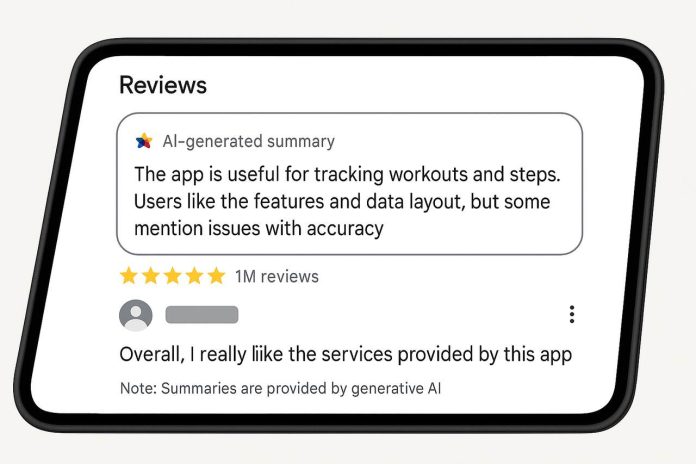Google has implemented AI-generated review summaries in the Play Store using Large Language Models (LLMs) to synthesize user feedback into concise, topic-relevant overviews. These summaries now appear on app listing pages, helping users grasp collective sentiment without reading thousands of individual reviews.
The AI system extracts high-frequency opinion clusters and key sentiment signals across multilingual reviews. Summaries are automatically refreshed to reflect the most recent feedback trends. The technology focuses on surfacing feature-specific sentiments, bug reports, and performance trends.
By incorporating Natural Language Processing (NLP) and opinion mining techniques, Google ensures that the summaries maintain semantic fidelity while reducing cognitive load for app researchers. These summaries align with the Experience-Product-Attribute model, helping potential users evaluate app quality at a glance.
What Are the Core Entities Involved in Google’s AI Review Summary Feature?
1. Google Play Store (Platform Entity)
The Google Play Store functions as the central application marketplace for Android users, hosting over 3.5 million apps. The platform now acts as a semantic content aggregator by integrating LLM-based summaries. The update positions the Play Store not just as a download hub but as a semantic feedback discovery interface.
2. Large Language Models (Technology Entity)
Google leverages Transformer-based LLMs fine-tuned on review classification, summarization, and aspect-based sentiment analysis. The model identifies sentiment-bearing lexical units and constructs coherence by aligning subjectivity cues across review segments. The models generate summaries in near real-time, dynamically adjusting based on newly submitted user reviews.
3. User Reviews (Data Entity)
User reviews act as the unstructured data corpus for training and inference. Reviews are parsed into aspect-opinion pairs, such as “fast performance” or “battery drain”, and encoded using vector semantics. Reviews written in various languages are semantically normalized using multilingual embeddings, ensuring consistency across geographies.
4. AI Summary Snippets (Interface Entity)
Each app listing now includes a condensed AI-generated snippet summarizing prevailing review themes. These summaries are categorized into satisfaction drivers (e.g., UI quality, battery use, reliability) and detractors (e.g., frequent crashes, lagging support). Snippets serve as Entity-Based Information Cards, enhancing user experience and discoverability.
5. Developers (Stakeholder Entity)
Developers gain immediate insights into review trends without needing to manually parse thousands of ratings. This semantic visibility helps product teams prioritize fixes, identify emerging UX issues, and optimize feature development. Google also provides APIs to access sentiment summaries for third-party analysis tools.
What NLP Techniques Power Google’s AI Summarization?
1. Aspect-Based Sentiment Analysis (ABSA)
ABSA identifies discrete entities (like “UI” or “battery”) and maps them to sentiment values (+/-). Google’s LLMs classify sentiment polarity per aspect to generate fine-grained summaries. This technique allows summarization to highlight precise user concerns.
2. Topic Modeling
Unsupervised models such as LDA or Neural Topic Modeling extract latent semantic topics from reviews. LLMs then summarize topics based on their frequency, sentiment distribution, and lexical variation across user cohorts.
3. Coreference Resolution
Coreference chains are resolved to maintain discourse continuity, ensuring that pronouns and synonyms refer accurately to the right entities in the summaries. This enables fluid multi-sentence summaries that retain high semantic clarity.
4. Semantic Embedding with Contextual Vectors
Transformer-generated embeddings like BERT or PaLM are used to map review phrases into high-dimensional semantic space. Clustering algorithms group semantically similar opinions, forming the foundation of the summarization logic.
5. Named Entity Recognition (NER) & Entity Linking
Review texts are scanned for brand names, feature sets, and technical components. These entities are linked to structured metadata in Google’s internal Knowledge Graph, improving relevance and filtering accuracy in the summary process.
How Does the Update Enhance UX and App Discoverability?
1. Improved Decision Efficiency
Users benefit from reduced decision friction by scanning summarized sentiment. NLP-generated highlights act as pre-evaluative filters, significantly shortening the time-to-decision for app downloads.
2. Personalized Review Summaries (A/B Testing Stage)
Google is experimenting with tailored summaries based on a user’s location, device type, and behavioral clusters. The system dynamically adjusts what summary is shown based on contextual entity weighting, increasing personalization relevance.
3. Visibility for Niche Apps
Smaller developers or apps with limited marketing budgets benefit from surfaced strengths like “simple UI” or “fast onboarding”, which might otherwise be buried in long-tail review threads. Summarization levels the playing field.
4. Semantic Trust Signals
Summaries that highlight transparency in pros and cons increase user trust and engagement. Balanced sentiment scoring and transparent trade-offs enhance the perceived authenticity of app listings.
5. Cross-Language Accessibility
Multilingual LLMs normalize sentiments across reviews written in Spanish, Hindi, and other global languages. This allows semantic unification across linguistic boundaries, making summaries globally inclusive.
What Are the Implications for Developers and Semantic SEO?
1. Real-Time Sentiment Monitoring
Developers can use summaries as a live sentiment dashboard. Keywords surfaced in summaries often mirror search queries, offering data-driven SEO signals for feature optimization.
2. Semantic Content Structuring
Summaries now act as machine-readable semantic data points. Structured opinion summaries improve entity indexing and feed into Google’s ranking systems for app visibility and related queries.
3. Query-Feature Alignment
App features highlighted in AI summaries often align with high-intent queries. Developers can revise Play Store descriptions and screenshots to reflect these high-engagement features, increasing conversion rates.
4. Feedback Loop for Feature Roadmaps
Summarized feedback accelerates product roadmap planning by offering quantified opinion clusters. Popular requests can be integrated into future updates, enabling a more agile development cycle.
5. Voice Search and Rich Snippet Integration
AI-generated summaries enhance voice search results and eligibility for rich snippets on Android search surfaces. Semantic consistency boosts cross-platform discoverability.
Summary Statement
Google’s integration of AI-powered review summaries in the Play Store reflects a pivotal evolution in semantic UX design, NLP application, and real-time opinion mining. The shift enhances app visibility, user trust, and decision efficiency—while signaling a future where entity-based SEO and dynamic content summarization become central to digital product ecosystems.
